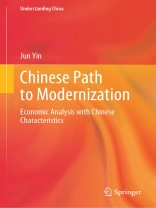This book exploratively reviews and refines the theoretical system of economics with Chinese characteristics and the analytical framework of Chinese path to modernization. This book aims to reveal answers to the three questions: what has the theoretical system of economics with Chinese characteristics inherited and developed? What are the experiences and lessons of all countries’ modernization in the world? What is the universality and particularity of Chinese Path to Modernization? As conclusion, the author draws a clue to understand Chinese path to modernization, which is neither “making up for the lessons” nor a “convergence”, but an “innovation” built upon the general principles of modernization. Its universality lies in the overall patterns and trends of modernization, that is, the consistent process of the country’s pursuit of national economic growth and people’s prosperity. The distinctiveness of this path lies in the concurrent transformation of Chinese economic system and the institutional innovations with Chinese characteristics that unfold throughout this ongoing economic process.
विषयसूची
Preface by Ping Xinqiao.- An Important Innovation Achievement of Economics Theory with Chinese Characteristics.- On Li Yining’s contribution to economics.- Introduction.- I. Formation of Economics Theory with Chinese Characteristics.- II. The Framework Structure and Main Content of this Book .- PART ONE.- Mutual Understanding and Inclusiveness.- The Origin and Development of Economics .- Chapter 1.- Theoretical Framework of Economics .- Section 1: Economics Is the Science of Social Enlightenment and Social Design.- I. What Economics Studies .- II. How to Study Economics.- III. Levels of Economic Theory Section 2: Ethics of Economics .- I. Ethics of Economics and the Study of Human.- II. The Study of Economics Ethics and Objectives.- Section 3: Economic Operation and System.- I. How to Achieve Efficiency and Fairness.- II. Economic System and Resource Allocation.- Section 4: Three Important Tools of Economists .- I. History.- II. Theory .- III. Statistics .-Chapter 2: A.- Hundred Flowers Blooming of Economics .- Section 1: A Mirror of Economic Doctrine History.- I. Classification of Economics .- II. Brief History of Economic Doctrines .- III. Crisis of Modern Western Economic Theory .- Section 2: The Integrator — Marxist Political Economics .- I. The Formation and Development of Marxist Political Economics.- II. The Scientific Laws Revealed by Marxist Political Economics .- Section 3: The Intersection of Economics and Other Disciplines.- I. The Trend of Interdisciplinary Intersection.- II. The Intersection of Economics and Other Disciplines.- Chapter 3: The Prosperity of Economics with Chinese Characteristics .- Section.- 1: Theoretical Starting Point and Innovative Development of Economics with Chinese Characteristics.- I. Theoretical Starting Point.- II. Practical Exploration and Theoretical Innovation of CPC in Leading Economic Work.- Section 2: Theoretical Features of Economics with Chinese Characteristics.- I. People-centered Economics.- II. The Basic Features of Socialist Economic Operation.- Section 3: Development Trend of Economics with Chinese Characteristics.- I. Systematic Economic Theory.- II. A Hundred Schools of Thought Contending and the Mission of Chinese Economists.- PART TWO.- Exploration of History–Success and Loss of Global Modernization.- Chapter 4: A Brief History of Global Modernization.- Section 1: Modernization of Western European Countries.- I. A Brief Modernization History of Western European Countries.- II. The Loss of British Modernization in the Twentieth Century.- Section 2: Modernization of United States.- I. The Establishment of the American Capitalist System.- II. The Process of Economic modernization of United States.- Section 3: Modernization of Other Countries .- I. Modernization of Other European Countries.- II. Modernization of Asia, Oceania, Africa, and Latin America countries.- Chapter 5: An Economic Analysis of the Success and Loss of Global Modernization.- Section 1: Comparative Economic History and Modernization .- I. Research Methods of Comparative Economics .- II. Modernization from the perspective of comparative economic history.- Section 2: The Basic Laws of Economic modernization .- I. The Economic Analysis Framework of Economic modernization.- II. Key Factors of Economic modernization.- Section 3: The Basic Laws of System Modernization.- I. The Economic Analysis Framework of System Modernization.- II. Key Factors of System Modernization.-PART THREE.-New Generation’s Mission for New Trail –The Universality and Particularity of Chinese Path to Modernization.- Chapter 6: Economic Analysis of Universality and Particularity of Chinese Path to Modernization.- Section 1: The Universality of Chinese Path to Modernization from the perspective of Economics.- I. A Consistent Logic of Economic modernization .-II. A Consistent Logic of System Modernization .-Section 2: The Particularity of China from the Perspective of Economic Modernization.- I.Development Economics and Two Types of Transformation.- II. Economic Operation and Two Types of Disequilibrium.- Section 3: The Particularity of China from the Perspective of System Modernization.- I. Planning System with Chinese Characteristics .- II. Development-oriented Finance System with Chinese Characteristics.- Chapter 7: To honor Commitment and take practical Actions of Chinese Path to Modernization.- Section 1: Chinese Path to Modernization Before the Reform and Opening Up.- I. Chinese Modernization in recent times.- II. Chinese Path to Modernization Under the Leadership of CPC Before the Reform and Opening up.- Section 2: Chinese Path to Modernization in the New Era of Reform, Opening Up, and Socialist Modernization .- I. Establishment of Socialist Market Economy and ‘Thought Guarantee’.- II. Modernization in the New Era of Reform, Opening Up, and Socialist Modernization.- Section 3: The New Journey of Chinese Path to Modernization and Theoretical Innovation.- I. High-quality Development Is of Paramount Importance in the New Era .- II. Implementing the New Development Philosophy .- III. The World Significance of Chinese Path to Modernization.- Conclusion:Where Does Modernization End?.
लेखक के बारे में
Dr. Jun Yin, the assistant Dean of Institute of Xi Jinping Thought on Socialism with Chinese Characteristics for a New Era, an assistant professor of Economics at Peking University. Yin obtained his Ph.D. degree from Guanghua School of Management, PKU. He was a postdoctoral research fellow under the supervision of Prof. Yining Li, a well-known economist known both in China and overseas as “Mr. Stock Market Li.” He was also a visiting scholar of Kennedy School of Government at Harvard University. His research areas include Chinese path to modernization, common prosperity, Xi Jinping’s economic thought, and organizational management, etc. He has published more than 50 articles in the prestigious academic journals. His books include China’s Plan for Economic and Social Development, The Road to New-type Urbanization in China, Low-carbon Economy, The Nature of Leadership. He won such honors as the 8th Award for Humanities and Social Sciences Research of Chinese Ministry of Education, Yang Fuqing – Wang Yangyuan Academician Outstanding Teaching and Scientific Research Award, Industrial and Commercial Bank of China Outstanding Teacher Award, the Popular Book Award by China Book Review Society, etc.












